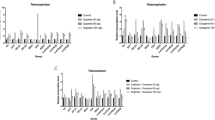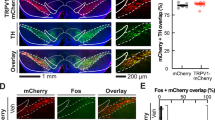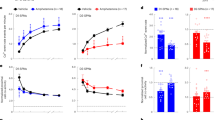Abstract
Current antipsychotic drugs are thought to inhibit central dopamine (DA) transmission by blocking DA receptors. Here, we provide evidence that the atypical antipsychotic drug clozapine may produce part of its effect by inhibiting a subset of excitatory inputs to DA neurons. Thus, in chloral hydrate-anesthetized rats, systemic administration of D-amphetamine produced two opposing effects on DA neurons in the ventral tegmental area. Under control conditions, D-amphetamine inhibited the firing of the cell through D2-like receptors. When D2-like receptors were blocked by raclopride, D-amphetamine excited DA neurons, instead of producing no effect. The excitation, expressed as an increase in firing rate and a slow oscillation in firing pattern, was suppressed by the adrenergic α1 receptor antagonist prazosin, suggesting an involvement of α1 receptors. In rats pretreated with the typical antipsychotic drug haloperidol, D-amphetamine also excited DA neurons. However, when given after clozapine, D-amphetamine produced no significant effects. The failure of D-amphetamine to produce an excitation is not due to an incomplete blockade of D2-like receptors by clozapine because co-treatment with clozapine and raclopride also failed to enable the excitatory effect of D-amphetamine. The suggestion that clozapine inhibits the excitatory effect of D-amphetamine is further supported by the finding that clozapine, given after D-amphetamine, reliably reversed D-amphetamine-induced excitation in raclopride-treated rats. Thus, different from raclopride and haloperidol, clozapine may inhibit DA transmission through two additive mechanisms: blockade of DA receptors and inhibition of an amphetamine-sensitive, excitatory pathway that innervates DA neurons.
Similar content being viewed by others
Log in or create a free account to read this content
Gain free access to this article, as well as selected content from this journal and more on nature.com
or
References
Auclair A, Blanc G, Glowinski J, Tassin JP (2004). Role of serotonin 2A receptors in the D-amphetamine-induced release of dopamine: comparison with previous data on alpha1b-adrenergic receptors. J Neurochem 91: 318–326.
Bunney BG, Aghajanian GK (1975). Antipsychotic drugs and central dopaminergic neurons: a model for predicting therapeutic efficacy and incidence of extrapyramidal side effects. In: Sudilovsky A, Gershon S, Beer B (eds). Predictability in Psychopharmacology: Preclinical and Clinical Correlations. Raven Press: New York. pp 225–245.
Bunney BS, Aghajanian GK (1978). D-Amphetamine-induced depression of central dopamine neurons: evidence for mediation by both autoreceptors and a striato-nigral feedback pathway. Naunyn Schmiedebergs Arch Pharmacol 304: 255–261.
Bunney BS, Walters JR, Roth RH, Aghajanian GK (1973). Dopaminergic neurons: effect of antipsychotic drugs and amphetamine on single cell activity. J Pharmacol Exp Ther 185: 560–571.
Cahir M, King DJ (2005). Antipsychotics lack [alpha]1A/B adrenoceptor subtype selectivity in the rat. Eur Neuropsychopharmacol 15: 231–234.
Cragg SJ (2003). Variable dopamine release probability and short-term plasticity between functional domains of the primate striatum. J Neurosci 23: 4378–4385.
Darracq L, Blanc G, Glowinski J, Tassin JP (1998). Importance of the noradrenaline-dopamine coupling in the locomotor activating effects of D-amphetamine. J Neurosci 18: 2729–2739.
Davis K, Kahn R, Ko G, Davidson M (1991). Dopamine in schizophrenia: a review and reconceptualization. Am J Psychiatry 148: 1474–1486.
Deutch AY (1992). The regulation of subcortical dopamine systems by the prefrontal cortex: interactions of central dopamine systems and the pathogenesis of schizophrenia. J Neural Transm Suppl 36: 61–89.
Farde L, Nordstrom AL, Wiesel FA, Pauli S, Halldin C, Sedvall G (1992). Positron emission tomographic analysis of central D1 and D2 dopamine receptor occupancy in patients treated with classical neuroleptics and clozapine. Relation to extrapyramidal side effects. Arch Gen Psychiatry 49: 538–544.
Gallager DW, Aghajanian GK (1976). Effect of antipsychotic drugs on the firing of dorsal raphe cells. I. Role of adrenergic system. Eur J Pharmacol 39: 341–355.
Gonon FG (1988). Nonlinear relationship between impulse flow and dopamine released by rat midbrain dopaminergic neurons as studied by in vivo electrochemistry. Neuroscience 24: 19–28.
Grace AA (1991). Phasic versus tonic dopamine release and the modulation of dopamine system responsivity: a hypothesis for the etiology of schizophrenia. Neuroscience 41: 1–24.
Grace AA, Bunney BS (1984). The control of firing pattern in nigral dopamine neurons: burst firing. J Neurosci 4: 2877–2890.
Groves PM, Wilson CJ, Young SJ, Rebec GV (1975). Self-inhibition by dopaminergic neurons. Science 190: 522–528.
Laruelle M (2000). The role of endogenous sensitization in the pathophysiology of schizophrenia: Implications from recent brain imaging studies. Brain Res Rev 31: 371–384.
Laruelle M, Abi-Dargham A, van Dyck CH, Gil R, D’Souza CD, Erdos J et al (1996). Single photon emission computerized tomography imaging of amphetamine-induced dopamine release in drug-free schizophrenic subjects. Proc Natl Acad Sci USA 93: 9235–9240.
Leysen JE, Janssen PM, Schotte A, Luyten WH, Megens AA (1993). Interaction of antipsychotic drugs with neurotransmitter receptor sites in vitro and in vivo in relation to pharmacological and clinical effects: role of 5HT2 receptors. Psychopharmacology (Berlin) 112: S40–S54.
Meltzer HY, Matsubara S, Lee JC (1989). Classification of typical and atypical antipsychotic drugs on the basis of dopamine D-1, D-2 and serotonin2 pKi values. J Pharmacol Exp Ther 251: 238–246.
Murase S, Grenhoff J, Chouvet G, Gonon FG, Svensson TH (1993). Prefrontal cortex regulates burst firing and transmitter release in rat mesolimbic dopamine neurons studied in vivo. Neurosci Lett 157: 53–56.
Pehek EA (1999). Comparison of effects of haloperidol administration on amphetamine-stimulated dopamine release in the rat medial prefrontal cortex and dorsal striatum. J Pharmacol Exp Ther 289: 14–23.
Seeman P (1995). Doapmine receptors: clinical correlates. In: Bloom FE, Kupfer DJ (eds). Pyschopharmacology: The Fourth Generation of Progress. Raven Press: New York. pp 295–302.
Shi WX (2005). Slow oscillatory firing: a major firing pattern of dopamine neurons in the ventral tegmental area. J Neurophysiol 94: 3516–3522.
Shi WX, Pun CL, Smith PL, Bunney BS (2000a). Endogenous DA-mediated feedback inhibition of DA neurons: involvement of both D(1)- and D(2)-like receptors. Synapse 35: 111–119.
Shi WX, Pun CL, Zhang XX, Jones MD, Bunney BS (2000b). Dual effects of D-amphetamine on dopamine neurons mediated by dopamine and nondopamine receptors. J Neurosci 20: 3504–3511.
Shi WX, Pun CL, Zhou Y (2004). Psychostimulants induce low-frequency oscillations in the firing activity of dopamine neurons. Neuropsychopharmacology 29: 2160–2167.
Sulzer D, Sonders MS, Poulsen NW, Galli A (2005). Mechanisms of neurotransmitter release by amphetamines: a review. Prog Neurobiol 75: 406–433.
Svensson TH, Tung CS (1989). Local cooling of pre-frontal cortex induces pacemaker-like firing of dopamine neurons in rat ventral tegmental area in vivo. Acta Physiol Scand 136: 135–136.
Vezina P, Blanc G, Glowinski J, Tassin JP (1991). Opposed behavioural outputs of increased dopamine transmission in prefrontocortical and subcortical areas: a role for the cortical D-1 dopamine receptor. Eur J Neurosci 3: 1001–1007.
Wang RY (1981). Dopaminergic neurons in the rat ventral tegmental area. III. Effects of—and—amphetamine. Brain Res Rev 3: 153–165.
Weinberger DR (1987). Implications of normal brain development for the pathogenesis of schizophrenia. Arch Gen Psychiatry 44: 660–669.
Welch JJ, Kim HS, Liebman J (1980). Amphetamine-induced increases in dopaminergic single cell firing rate after haloperidol pretreatment. Correlation with extrapyramidal side effects. Neuropharmacology 19: 371–377.
Zhou Y, Bunney BS, Shi WX (2006). Differential effects of cocaine on firing rate and pattern of dopamine neurons: role of {alpha}1 receptors and comparison with L-dopa and apomorphine. J Pharmacol Exp Ther 317: 196–201.
Acknowledgements
This work was supported in part by NIDA DA12944 (WXS), a NARSAD Independent Investigator Award (WXS), and a NARSAD Distinguished Investigator Award (BSB).
Author information
Authors and Affiliations
Corresponding author
Rights and permissions
About this article
Cite this article
Shi, WX., Zhang, XY., Pun, CL. et al. Clozapine Blocks D-Amphetamine-Induced Excitation of Dopamine Neurons in the Ventral Tegmental Area. Neuropsychopharmacol 32, 1922–1928 (2007). https://doi.org/10.1038/sj.npp.1301334
Received:
Revised:
Accepted:
Published:
Issue date:
DOI: https://doi.org/10.1038/sj.npp.1301334



